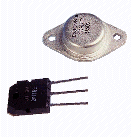|

A semiconductor is a crystalline material
that is neither a good conductor of electricity (like copper) nor
a good insulator (like rubber). It has intermediate values of
electrical resistivity (its electrical conductivity at room
temperature is between that of a conductor and that of an
insulator). At high temperatures its conductivity approaches that
of a metal and at low temperatures it acts as an insulator. The
most common semiconductor materials are silicon and germanium.
Silicon is by far the more widely used semiconductor for
electronics, partly because it can be used at much higher
temperatures than germanium. These materials can either be used in
their pure “intrinsic” forms or can be doped to create an excess
or lack of electrons. Doping involves adding elements into a
semiconductor material during the manufacturing process to
increase its conductivity. The impurities added are called dopants.
Common dopants include arsenic, antimony, bismuth and phosphorous.
The type and level of doping determines whether the semiconductor
is N-type (negative), where the current is conducted by excess
free electrons or P-type (positive), where the current is
conducted by electron vacancies. A semiconductor device is any of
a wide variety of devices that employ the electrical properties of
semiconductor materials to control the flow of electrons. Such
devices include diodes, transistors, logic devices, integrated
circuits, voltage regulators, operational amplifiers, etc

A diode is a two-terminal electronic device
containing an anode and a cathode, that permits current flow
predominantly in only one direction. It has a low resistance to
electric current in one direction and a high resistance to it in
the reverse direction. This property makes a diode useful as a
rectifier, which can convert alternating current (AC) into direct
current (DC). When the voltage applied in the reverse direction
exceeds a certain value, a semiconductor diode “breaks down” and
conducts heavily in the direction of normally high resistance.
When the reverse voltage at which breakdown occurs remains nearly
constant for a wide range of currents, the phenomenon is called
avalanching. A diode using this property is called a Zener diode.
It can be used to regulate the voltage in a circuit. Semiconductor
diodes can be designed to have a variety of characteristics.
Light-sensitive or photosensitive diodes can be used to measure
illumination; the voltage drop across them depends on the amount
of light that strikes them. A light-emitting diode (LED) produces
light as current passes through it.


A logic circuit is an electric circuit
whose output depends upon the input in a way that can be expressed
as a function in symbolic logic; it has one or more binary inputs
(capable of assuming either of two states, e.g., “on” or “off”)
and a single binary output. Logic circuits that perform particular
functions are called gates.
|
|
|
Basic logic circuits include the AND
gate, the OR gate, and the NOT gate, which perform the logical
functions AND, OR, and NOT. Logic circuits can be built from any
binary electric or electronic devices, including switches, relays,
electron tubes, solid-state diodes, and transistors; the choice
depends upon the application and design requirements.

 A
transistor is an active semiconductor device, which possesses at
least three terminals (typically, a base, emitter, and collector).
A small current in the centre or base region can be used to
control a larger current flowing between the end regions (emitter
and collector). It is characterised by its ability to amplify
current and is used in a wide variety of equipment such as
amplifiers, oscillators and switching circuits. (It is a shortened
form of transfer resistor.) A
transistor is an active semiconductor device, which possesses at
least three terminals (typically, a base, emitter, and collector).
A small current in the centre or base region can be used to
control a larger current flowing between the end regions (emitter
and collector). It is characterised by its ability to amplify
current and is used in a wide variety of equipment such as
amplifiers, oscillators and switching circuits. (It is a shortened
form of transfer resistor.)

An electronic circuit built on a
semiconductor substrate, usually one of single-crystal silicon.
The circuit, often called a chip, is packaged in a hermetically
sealed case or a non-hermetic plastic capsule, with leads
extending from it for input, output, and power-supply connections
and for other connections that may be necessary when the device is
put to use. Integrated circuits can be classified into two groups
based on the type of transistors they contain. Bipolar integrated
circuits contain bipolar junction transistors as their principle
elements. Metal-oxide-semiconductor (MOS) integrated contain MOS
transistors as their principle elements. Some integrated circuits
contain both types of transistors. Integrated circuits are also
categorised according to the number of transistors or other active
circuit devices they contain. An IC is said to use small-scale
integration (SSI) if it contains fewer than 10 transistors. An IC
that contains from 10 to 100 transistors is said to use
medium-scale integration. A large-scale integration (LSI) IC
contains from 100 to 1,000 transistors, and one that uses
very-large-scale integration (VLSI) contains more than 1,000
transistors. Some integrated circuits are analogue devices; an
operational amplifier is an example. Other ICs, such as the
microprocessors used in computers, are digital devices. Some
hybrid integrated circuits contain both analogy and digital
circuitry; a bilateral switch, which switches analogy signals by
means of a digital control signal is an example of a hybrid IC.
Integrated circuit functions are virtually limitless. Improvements
in IC manufacturing have led to increasingly dense and capable
integrated circuits.

A circuit or device that produces a nearly
constant voltage output, even though the voltage input (line) and
current output (load) vary widely.

An amplifier characterised by very high
gain and input impedance, and very low output impedance. The
output voltage is proportional to its input voltage with gain |
|
![]()